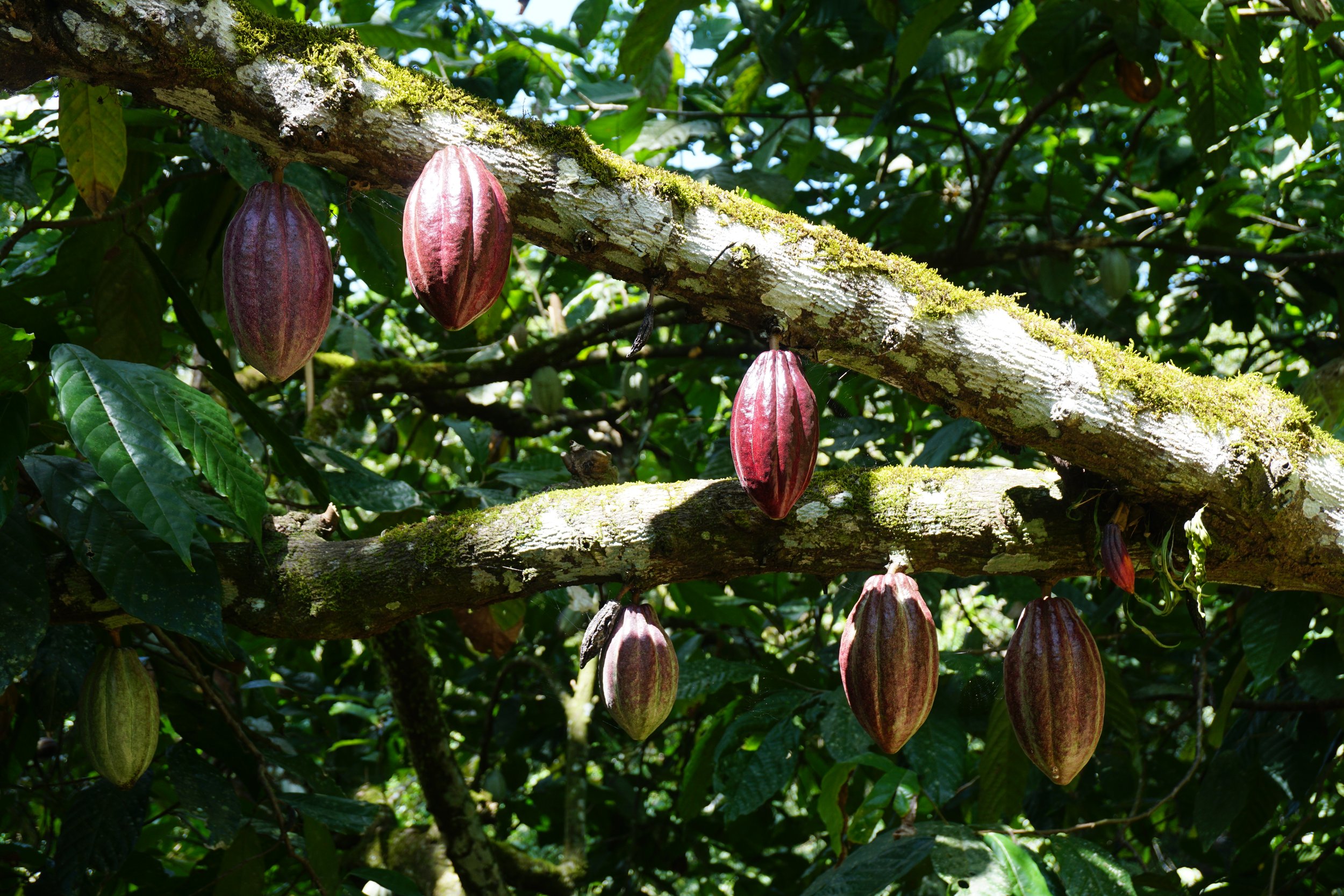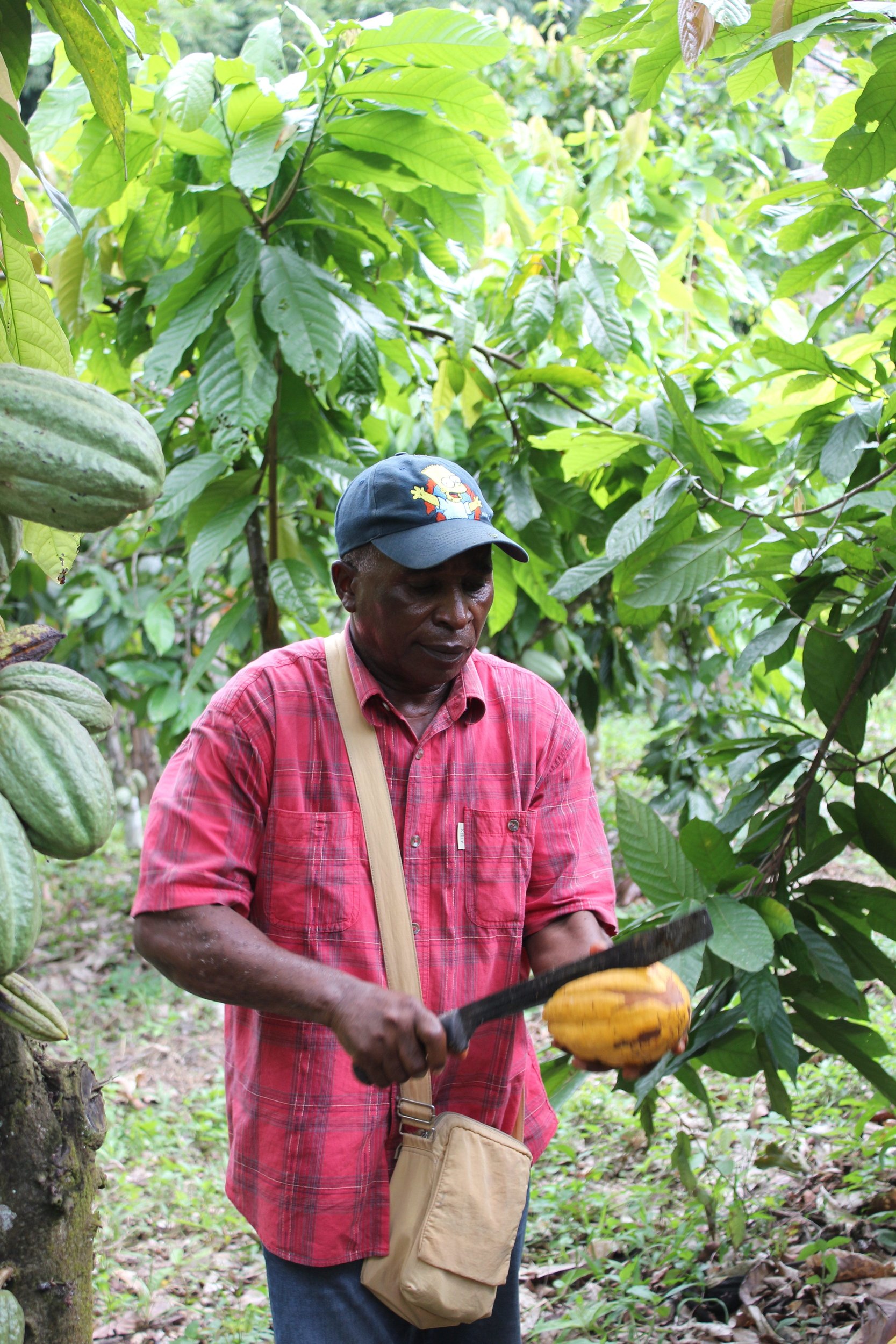Who Grows the Cacao in Your Chocolate?
Cacao pods growing on a tree at a CONACADO cooperative farm in the Dominican Republic.
You probably already know that cacao is the crop from which cocoa and chocolate are made. An estimated 5.5 million farmers grow cacao in over 50 countries. The vast majority of cacao, over 70%, is now grown in West African countries like Ghana and Côte d’Ivôire, with smaller but still significant amounts grown in Central and South America and Asia. Starting around 2000, labor abuses in the cocoa industry began to get international attention. You may have heard about poverty wages, unsafe working conditions, the worst forms of child labor and even modern-day slavery. You may have heard that farming practices that damage the environment were common, too. But what’s going on with that now? Have things gotten any better? Let’s take a look at the current state of affairs in the chocolate industry, and what you can do to help.
Taking the measure of the cacao industry
A split cacao pod. Chocolate is made from the dried and fermented seeds of this plant.
Every two years, a global consortium of organizations, including Green America, the International Labor Rights Forum and Oxfam, publishes a report called The Cocoa Barometer. Though minor progress has been made in the industry in recent years, the 2020 Cocoa Barometer doesn’t show much good news on the horizon for cacao farmers. As the executive summary puts it, “Twenty years into rhetoric, the challenges on the ground remain as large as ever. Poverty is still the daily reality for virtually all West African cocoa farmer families, child labour remains rife, and old-growth forests continue to be cleared to make way for cocoa production.” These are complex and entrenched challenges that need radical changes at the systemic level. While much of the conversation has been around interventions on farms or in producing countries, the major burden for change has failed to sufficiently fall on the shoulders of the largest multinationals, who have concentrated power and gained massive profits from this system.
Here are some of the biggest challenges:
The price of the crop is unstable and unfair. Farmers are at the mercy of a market that is driven by supply and demand rather than the cost of production and the need to make a living. The system is built on a lack of transparency and traceability that removes the human connections and realities from decision making. Prices are driven by algorithms, traders and speculation rather than conversations between everyone in the value chain. This leaves farmers disempowered and vulnerable to rapid and drastic price changes completely out of their control. By way of example, between August 2016 and February 2017, the price of cocoa cratered, dropping from around $3,000 per ton to below $2,000 per ton. Smallholder farmers who are most vulnerable to price drops saw the value of their product unexpectedly drop by 33% and without a guaranteed minimum price, they bear all the risks of this volatile market. They can’t afford it! A report by Fairtrade International calculates that farmers in Côte d’Ivôire earn an average income of just $0.92 per day. That’s 37% of what’s considered a living income in rural Côte d’Ivôire. 2023 and 2024 have seen historic high prices in the cocoa market, which is good news for most farmers. Yet, even with these high prices farmers still struggle to get paid and the main driver of the price is lower production for many farmers due to the impact of weather and disease.
10 Year Cocoa Futures Data in US Dollars per Metric Ton, showing the volatility of the market.
Fountain, A. C., & Huetz-Adams, F. (2020). Cocoa Barometer. VOICE Network.
Cocoa still depends on child labor. Though growing and harvesting cacao can be hazardous for anyone, the most recent research by the National Opinion Research Center at the University of Chicago (NORC 2020) estimated that in Ghana and Côte d’Ivôire alone 1.5 million children currently perform this work. The vast majority of these children are working on family farms but due to the imbalance of power and profits in the chocolate industry, many encounter some sort of unsafe working conditions. The reasons and solutions are complex but the problem has long been visible.
“The credibility of the cocoa sector to make good on promises to tackle child labour has reached discouragingly low levels. Over the past two decades, many promises were made. None were met. The first such promise was to eliminate child labour by 2005. The last such promise, made in 2010, was to come to a reduction of 70% of the worst forms of child labour by 2020.”
While the NORC report shares some hopeful updates and trends, this remains a problem driven by the larger system that is based on the industry's need for cheap raw materials and cheap chocolate, lack of transparency and lack of farmer voices.
Cacao farming contributes to deforestation. Historically, in many countries cacao has been a slash-and-burn crop and global cacao production has increased fourfold since 1960. More than 70 percent of the original forests in Côte d’Ivôire and Ghana have been destroyed, largely due to cocoa production. In the 2018 edition, the Cocoa Barometer attributes this damage to a combination of “corporate disinterest in the environmental effects of the supply of cheap cocoa, and to an almost completely absent government enforcement of environmentally protected areas.” In the face of this challenge, the European Union will implement a new European Union Deforestation Regulation in early 2025. While challenging to implement for smallholder cocoa farmers across the globe, this new regulation should dramatically reduce deforestation across the entire industry.
Individual decisions matter
These problems are hard to tackle—and big corporations aren’t doing enough. The Hershey Company, Kraft Foods, Mars Incorporated and Nestle signed the Harkin-Engel Protocol in 2001, showing they were aware of the problem and resolving to take action. But as the continued widespread use of child labor in the cocoa industry shows, the Protocol has failed. More must be done.
What can we do, as individuals? Here are some suggestions for disrupting the “business as usual” attitude that the Cocoa Barometer talks about.
You can tell your friends about what’s happening in the West African chocolate industry. Show them the 2022 Cocoa Barometer or Equal Exchange’s Chocolate Infographic.
You can let big companies know that you care about this issue and that you’re paying attention to how they handle it! Write to Harkin-Engel Protocol signatories, or tag them on social media. These big players need to hear from customers that abusive practices aren’t acceptable, so that they have motivation to change their systems.
You can opt out of chocolate produced by an unfair system. Eat less chocolate or — even better—switch to fair trade chocolate that’s traceable, so you can feel confident about the conditions under which it was produced. Find out which brands are rated highly on Green America’s Chocolate Scorecard.
Ramon Mosquea and Glenys Rosario are technical staff of CONACADO, one of Equal Exchange’s partner co-ops in the Dominican Republic.
What about Equal Exchange chocolate?
We currently source the majority of our cacao from Latin America but in 2018 we began partnering with organizations and farmers in West Africa, specifically in the country of Togo. We work only with democratically organized groups that are part of the fair trade movement and have the vision of improving the lives of farmers and their communities. We visit our partners, with whom we’ve established personal relationships. They are smallholder farmers who are proud of their work and want to sell organic cacao for delicious chocolate through a fair system. Equal Exchange products have full traceability back to our farmer cooperative partners. Equal Exchange guarantees a minimum price to the cooperatives and pays higher prices for the work that goes into organic cocoa production. Equal Exchange only sources cacao and sugar from organic certified cooperatives and farmers who are working to farm more in harmony with the environment and in ways that are beneficial to local and regional ecosystems. Additionally, the advance credit our partners receive helps them weather the ups and downs of the market, improve their farming practices, and plan for their families’ futures.
Chocolate shouldn’t be cheap. It should be fairly produced, and delicious!
Photos, clockwise from top left: Members of the ACOPAGRO co-op in Peru and their children pose with cacao pods; farmers from SCOOPS IKPA Cooperative, one of our newest cacao producer partners in Togo.
Resources:
Cocoa Barometer 2020 and Cocoa Barometer 2022 by the Barometer Consortium.
NORC Final Report: Assessing Progress in Reducing Child Labor in Cocoa Production in Cocoa Growing Areas of Côte d’Ivoire and Ghana by the National Opinion Research Center at the University of Chicago (NORC 2020)
Shop our selection of organic and fairly traded chocolate bars, chocolate chips, and cocoas, including Organic Total Eclipse 92% dark chocolate, featuring cacao from our newest partners in Togo.










